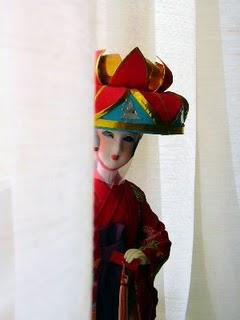Under the Cherry Tree, Japanese Dolls from the Collection of Hatsuko Ohno (11/5/2008 - 2/22/2009)

For the first time a number of Japanese traditional dolls from the collection of Hatsuko Ohno (1915-1982), a renowned doll maker, are touring Vienna, Austria in the exhibit Unter dem Kirschbaum, Japanische Puppen aus der Sammlung Hatsuko Ohno (Under the Cherry Tree, Japanese Dolls from the Collection of Hatsuko Ohno). Her dolls have spent some time in Poland, Hungary, and Italy.
Call it an exhibit within an exhibit. Only a welcoming arch, which is made of hard cardboard painted in soft salmon-pink emblazoned with white silk-screened cherry tree leaves, creates an illusion that one is entering a different zone.
The less than 50 fifty dolls, mostly in female form, are stored in two glass cases located in the last room of the permanent Imperial Silver Collection in the Silberkammer of Hofburg, the former winter palace of the Habsburg monarchs and the present-day office of the president of Austria. The dolls are surrounded by the porcelain wares that were produced in Korea and Japan in the nineteenth century and previously owned by the Duke of Habsburg-Lorraine.
Dolls are called ningyo, which means “human form” in English, and come in different types. According to the information on the wall, they “are associated with numerous meanings and functions, fertility rituals and the cult of dead.” They represent warriors, fairytale figures, children, Kabuki actors, musicians, and the everyday scenes of Japanese life. They have an “apotropaic function at folk festivals and religious ceremonies” and also serve as “amulets and talismans.” No wonder the kamikaze pilots carried masukotto ningyo to protect them from danger.
Ningyos had been produced since the early days of Japanese civilization. During the Edo Period (1603-1868) dollmaking reached its popularity. Yet, it took time till it was considered as an art. Dolls used to be exclusive to aristocracy. Giving them as presents to the imperial court was a common practice until it spread to lower social classes in the latter years. Today one can readily order ningyo off the Internet that fetches from $20 to $4,000 a piece, depending on its age and complexity of work.
Doll makers use different materials. Ohno, for example, carved her sakura dolls (shelf dolls) out of Paulownian wood, a tree native to China, with sawdust, and dressed them in silk and other fabrics. She got her inspiration from her own childhood and the Edo Period. What caught my attention was a tragic barefooted female ningyo ready to trample on the Bible in front of her. Many Christians during this era were forced to renounce their faith, or else, face torture and death.
Hopefully, this is only the beginning of many more exhibits concerning the Japanese traditional dolls to come in Europe. In the U.S. there are several comprehensive seminars about antique and modern ningyos. A genuine interest has established considering the number of workshops available nationwide.
My only complaint: Although the collection is an interesting lot, it is hidden from the public eye. One has to brave the labyrinthine paths in order to find the dolls. A hasty museum visitor might just drop the idea of searching for them except he or she is there for this purpose: the ningyos.